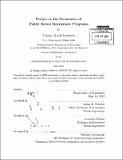| dc.contributor.advisor | James M. Poterba and Jonathan Gruber. | en_US |
| dc.contributor.author | Leiserson, Gregory Quick | en_US |
| dc.contributor.other | Massachusetts Institute of Technology. Department of Economics. | en_US |
| dc.date.accessioned | 2013-09-24T19:38:29Z | |
| dc.date.available | 2013-09-24T19:38:29Z | |
| dc.date.copyright | 2013 | en_US |
| dc.date.issued | 2013 | en_US |
| dc.identifier.uri | http://hdl.handle.net/1721.1/81035 | |
| dc.description | Thesis (Ph. D.)--Massachusetts Institute of Technology, Dept. of Economics, 2013. | en_US |
| dc.description | Cataloged from PDF version of thesis. | en_US |
| dc.description | Includes bibliographical references. | en_US |
| dc.description.abstract | This thesis investigates the influence of retiree health and pension policies on the retirement decisions of public sector employees. Chapter one documents the central role of eligibility for subsidized retiree health insurance. Using administrative records obtained from the Pennsylvania State Employees Retirement System, the analysis finds that the well-documented spike in the separation rate at the normal retirement age almost completely disappears in the population of workers not yet eligible for subsidized retiree health insurance. A second set of results exploits quasi-experimental variation in plan design to show that increasing the service requirement for subsidized retiree health insurance stretches the distribution of separations: early separations occur earlier and late separations occur later. Chapter two presents a structural analysis of the retirement decision for the same employees. Existing models of the retirement decision treat eligibility as a fixed characteristic of the worker rather than one that evolves over the career. This chapter estimates a model of life-cycle labor supply and uses it to simulate labor supply behavior under different health and pension policies. Changes in the eligibility requirements for subsidized retiree health insurance induce dramatic changes in retirement timing that would be missed in models that do not account for an employer's eligibility criteria. Chapter three turns to the defined benefit pension plans common in the public sector. These plans create complicated incentives in favor of continued work at some ages and in favor of retirement at others. The strength of these incentives depends on many factors, such as the age of initial employment and the number of years on the job. Because employees differ along these dimensions, the value of the pension benefits earned over the course of a career varies substantially-even among employees with the same total earnings. This chapter investigates the incentive effects and distributional consequences of four stylized plan designs. It derives simple formulas for the accrual rate of pension wealth and the distribution of benefits under each of the plans and uses these formulas to gain insight into the incentives and risks they create. | en_US |
| dc.description.statementofresponsibility | by Gregory Quick Leiserson. | en_US |
| dc.format.extent | 175 p. | en_US |
| dc.language.iso | eng | en_US |
| dc.publisher | Massachusetts Institute of Technology | en_US |
| dc.rights | M.I.T. theses are protected by
copyright. They may be viewed from this source for any purpose, but
reproduction or distribution in any format is prohibited without written
permission. See provided URL for inquiries about permission. | en_US |
| dc.rights.uri | http://dspace.mit.edu/handle/1721.1/7582 | en_US |
| dc.subject | Economics. | en_US |
| dc.title | Essays on the economics of public sector retirement programs | en_US |
| dc.type | Thesis | en_US |
| dc.description.degree | Ph.D. | en_US |
| dc.contributor.department | Massachusetts Institute of Technology. Department of Economics | |
| dc.identifier.oclc | 857791220 | en_US |
